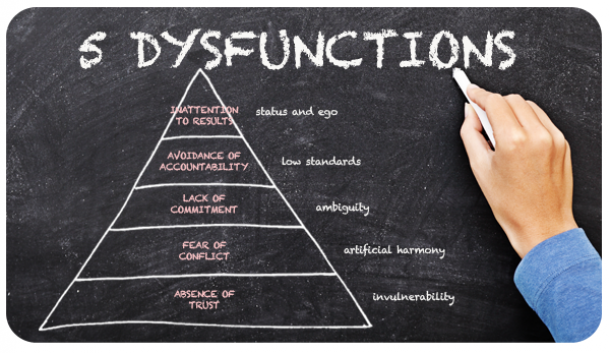In a Nutshell: The 5 Dysfunctions of a Team
"The Five Dysfunctions of a Team: A Leadership Fable" (2002) is a bestselling business book written by Patrick Lencioni in the form of a parable (a narrative with fictional characters used to convey its main points). The author presents a model for team building that has become one of the most popular among HR and training professionals.The story follows Kathryn Petersen, a newly appointed CEO of a company called DecisionTech, a Silicon Valley firm with innovative products, the best talent, plenty of capital, and for all intents and purposes should be outperforming their competitors, but isn’t. The company is ultimately lagging in the market due to what would appear to be, at least on the surface, a relatively harmless issue: lack of cohesion between the senior executive team. In reality, Kathryn knows it threatens to bring down the entire company. The new CEO decides to take the 7-member team on a series of off-site workshops to address the root issue at the heart of the company's troubles, which is where she presents the group with a 5-level framework.
Overview
The 5 Dysfunctions Model, presented in the shape of a pyramid, suggests that there are 5 basic, interrelated issues that undermine the performance of any team.

1. Absence of Trust: Unwillingness to be vulnerable within the team.
Team members who are not genuinely open with one another about their weaknesses and mistakes make it impossible to build a foundation of trust. Lencioni suggests that vulnerability-based trust (how open and accepting you are) trumps credibility-based trust (how skilled and technically competent you are) because only when people feel truly comfortable with one another can they focus on the work at hand without fear of protecting their ego, playing political games, or having to compete with their peers for recognition. It is crucial that the leader is able to demonstrate vulnerability first by having the courage to set a good example. Several tools are suggested for overcoming the 1st dysfunction including sharing personal histories (e.g., hometown, hobbies, first job experience, etc.), personality and behavioural preference profiles, and other team building exercises (e.g., discuss your greatest strength and your biggest challenge at work).
2. Fear of Conflict: Unwillingness to have open, constructive debate.
Once people can trust their teammates, they will be able to work through healthy conflict and have candid, passionate debate. Without serious debate, people resort to superficial discussions, hide their true feelings, and ideas cannot be properly tested. Having open conflict does not mean calling people names or attacking their personal credibility in order to win an argument. Instead, Lencioni is describing the productive kind of conflict that helps people air their concerns, present their evidence, have disagreements, and quickly come to the best solution. Even though total agreement may not always be reached in every case, the important thing is to ensure everyone knows that their opinion matters and will be heard.
3. Lack of Commitment: Feigning agreement with a decision or strategy.
Once people can rigorously test an idea through open debate and have their say, they will be more willing to take ownership of the idea and commit to making it a reality. Commitment means that people leave meetings with clarity around what they need to achieve and don’t have any unresolved issues that would prevent them from being fully engaged. The two main derailments of commitment are lack of certainty (or clarity) and consensus (or buy-in). The leader should never assume that everyone on the team is 100% committed. Pretending to agree with the group for the sake of appearances is a common occurrence in a dysfunctional team.
4. Avoidance of Accountability: Unwillingness to call peers out on counterproductive behaviour.
Once people are fully committed, they can set standards for performance and this means having the willingness to discuss others’ unproductive behaviour. Accountability means more than taking personal responsibility; it means holding others accountable — a form of “productive peer pressure.” Lencioni says there is nothing like the fear of letting down respected teammates that motivates people to improve their performance.
5. Inattention to Results: Putting personal success and ego ahead of the team.
Only once people feel truly part of a team and are committed to the collective needs of the group are people willing to sacrifice their own comfort to help others succeed. There are two main things that get in the way of attending to results: team status (where people don’t give their best because they are satisfied with the status quo) and individual status (where people seek to advance their own interests). One of the ways to prevent this is to tie individual rewards and recognition to the performance of the team as a whole.
Although the model is explained in the case of a senior executive team at a technology company, it is seen as being applicable to any team in any organisation, including sports, community groups, as well as in families.
This article offers an expanded description of the summary listed in our post 40 Must-Know HR, OD, L&D Models.
For more information, purchase the book on Amazon: The Five Dysfunctions of a Team.

Theo Winter
Client Services Manager, Writer & Researcher. Theo is one of the youngest professionals in the world to earn an accreditation in TTI Success Insight's suite of psychometric assessments. For more than a decade, he worked with hundreds of HR, L&D and OD professionals and consultants to improve engagement, performance and emotional intelligence of leaders and their teams. He authored the book "40 Must-Know Business Models for People Leaders."



We Would Like to Hear From You (0 Comments)